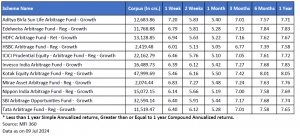Indian stock indices are now among the most expensive in the world. There are increasing murmurs of the likelihood of a correction. Nonetheless, the equity market is going onward and forward, all guns blazing!
Some friends have booked little profits in stocks and were enquiring with me about where to park the proceeds. Liquid funds are the primary choice for safety and short-term parking. Liquid funds invest in Treasury bills issued by the Government of India that mature in three months. It is a very low-risk option, with a lock-in for only a week. This flexibility allows you to redeem funds at any time, giving you the power to manage your investments as per your needs.
Liquid funds fall into the debt funds category, so all gains, long-term or short-term, are taxed at the marginal rate of your slab.
Arbitrage funds, although not considered as safe as liquid funds, are another option for parking funds. The beauty of these funds is that they fall in the equity funds category and are taxed likewise. Short–term: holding less than a year @ 15% and over one year @ 10%.
How do Arbitrage funds work?
Markets are inherently imperfect, and arbitrage exploits these flaws to your advantage. It’s about seizing any opportunity to profit from a price anomaly or a price difference.
Here’s a simple example to illustrate arbitrage. Sometimes, the price of the same stock may differ slightly on the NSE and the BSE. You can buy it on one exchange and sell it on the other; the price difference is your profit, known as the spread.
Arbitrage funds do something slightly more complex than buying and selling within exchanges, so we need to understand different segments of markets.
When you buy a stock and pay in full for it or sell it and take full consideration, it’s called trading in cash markets or spot prices.
On the other hand, more experienced or bigger risk-takers operate in the futures and options market and bet on stock prices rising or falling. They can do that without investing the full price and make or lose big bucks.
Typically, futures prices of a stock trade are at a premium to the spot (current-day) price. On any given day, if someone offers you payment today or after a month, you will take it immediately. You can invest the money and earn interest for a month.
Thereby, the future price of a stock is always a bit higher and follows the short-term interest rates.
To understand more about Futures and Options, you can click here & here.
Say Stock Gamble’s Spot (cash segment) price is 2000, and the contract of future Price after a month is 2025.
The arbitrage fund manager would buy Gamble stock in the Cash segment and simultaneously sell the same quantity in one month’s futures segment.
Typically, after a month, suppose the price of Gamble in the cash segment is 2030. They would sell in the spot market, make Rs. 30, and buy in the futures market, incurring a Rs 5 loss (as they had sold @2025). The fund manager would make Rs. 25 on the trade. However, they will need to deduct the transaction costs.
Even if the markets went reverse and the stock price in the spot market was trading at, say, Rs 1990, a loss of Rs. 10 in cash and a profit of Rs. 35 in futures, the spread or net profit would be Rs. 25 on the transaction.
The fund managers of Arbitrage funds run as many positions as they can concurrently and make a return. Sometimes, there are many arbitrage opportunities because of bullish markets and high interest rates. The returns on arbitrage funds can be comparable or even beat those of liquid and money market funds.
Arbitrage fund managers work all day long, looking for opportunities and investing in them when they present themselves.
What kind of returns have Arbitrage funds given in the past?

The key thing to understand is that Arbitrage funds invest 65% or more in equity but do not have the volatility or high returns of equity because they simultaneously buy in the cash segment and sell in the futures segment. In other words, it’s a fully hedged equity portfolio.
The balance 35% they invest in debt and other treasury bills, bonds, etc.
The team at the fund house has to watch out and work very hard to look for good opportunities and seize them immediately.
What are some Downsides to Arbitrage funds?
Opportunities for earning a decent spread in arbitrage are not always present. Typically, in bearish markets, traders’ interest wane. Sometimes, the entry and exit of large institutional players in some stocks determine the cash and futures prices.
Ultimately, returns should be monitored carefully, and if the funds consistently underperform, the investor can take due action.
Please remember that Arbitrage funds typically have a week’s exit load, meaning you will have to pay a penalty (about 0.25% of the NAV) if you exit the fund within a week of investment.
The long-term tax of 10% of equitymf on Arb funds is the show’s star, and hopefully, the finance minister will not tinker with it in this year’s budget.


Sejal Goel
This is something new i read for the first time -Arbitrage Funds. Not very simple concept but you made it simple through this article. I liked the example of the stock named Gamble. This example made it easy to understand the concept of Arbitrage funds. Easy to understand very well written article as always Amita.
Ofmoneyandmoney.com always brings something interesting and teaches us something new.
Amita
Thankyou Sejal Goel.